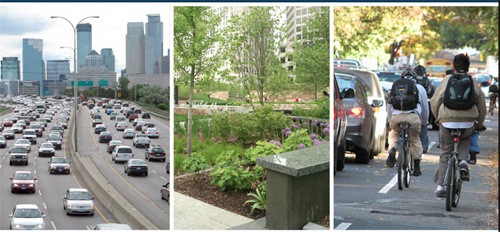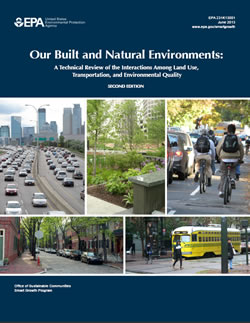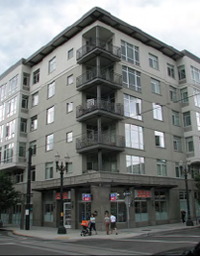Navigation
How To Reduce Environmental and Human Health Impacts of Development
How the built environment, the way we build our cities and towns, directly affects our environment and public health is considered in a comprehensive U.S. Environmental Protection Agency report released on June 17, 2013. The report and associated resources offer advice on how to reduce environmental and human health impacts of development.
 Our Built and Natural Environments Report Provides Guidance to Protect Human Health and the Environment: Photograph courtesy of the U.S. EPA
Our Built and Natural Environments Report Provides Guidance to Protect Human Health and the Environment: Photograph courtesy of the U.S. EPA
How the built environment, the way we build our cities and towns, directly affects our environment and public health is considered in a comprehensive U.S. Environmental Protection Agency report released on June 17, 2013. The report and associated resources offer advice on how to reduce environmental and human health impacts of development.
The publication, “Our Built and Natural Environments: A Technical Review of the Interactions among Land Use, Transportation, and Environmental Quality,” provides evidence that certain kinds of land use and transportation strategies – where and how we build our communities -- can reduce the environmental and human health impacts of development.
 The second edition of Our Built and Natural EnvironmentsDownload: The second edition of Our Built and Natural Environments (PDF). (About this PDF):
The second edition of Our Built and Natural EnvironmentsDownload: The second edition of Our Built and Natural Environments (PDF). (About this PDF):
“Although findings might differ on the magnitude of the effects of different practices, the evidence is overwhelming that some types of development yield better environmental results than others,” the report asserts.
Decisions about how and where we build our communities have significant impacts on the natural environment and on human health. Cities, regions, states, and the private sector need information about the environmental effects of their land use and transportation decisions to mitigate growth-related environmental impacts and to improve community quality of life and human health.
In 2001, EPA published Our Built and Natural Environments: A Technical Review of the Interactions Between Land Use, Transportation, and Environmental Quality to show how development patterns affect the environment and human health. Since then, research has continued to clarify and better explain these connections.
To capture this research, EPA has revised and updated the report, incorporating key findings from hundreds of studies.
The new report:
 Children might be more vulnerable to exposure to indoor air contaminants because their lungs and: metabolic systems are still developing and they breathe and eat more per pound of body weight than adults. Children also play close to the ground where they might consume contaminated dust and tracked-in pollutants, and they might put toys and household objects in their mouths. Photograph source: Ramona Gaukel via stock.xchng
Children might be more vulnerable to exposure to indoor air contaminants because their lungs and: metabolic systems are still developing and they breathe and eat more per pound of body weight than adults. Children also play close to the ground where they might consume contaminated dust and tracked-in pollutants, and they might put toys and household objects in their mouths. Photograph source: Ramona Gaukel via stock.xchng
- Discusses the status of and trends in land use, development, and transportation and their environmental implications.
Findings include: 1
- The U.S. population is projected to grow 42 percent between 2010 and 2050, from 310 million to 439 million (Vincent and Velkoff 2010).
- While the population roughly doubled between 1950 and 2011 (U.S. Census Bureau), vehicle travel during this same period increased nearly sixfold (Federal Highway Administration 2010 and 2012)
However, evidence suggests that the growth of vehicle travel might be slowing in recent years.
Virtually every metropolitan region in the United States has expanded substantially in land area since 1950—including regions that lost population during that time (U.S. Census Bureau).
 Mayfly: Mayflies live just a few days as adults but spend months or even years as larval nymphs in freshwater streams or ponds.: They are a favorite food for fish and other aquatic predators and require water with a neutral pH and high levels of dissolved oxygen. They cannot tolerate pollution, making them important water quality indicators. Photograph by Andy Nelson via Flickr.com
Mayfly: Mayflies live just a few days as adults but spend months or even years as larval nymphs in freshwater streams or ponds.: They are a favorite food for fish and other aquatic predators and require water with a neutral pH and high levels of dissolved oxygen. They cannot tolerate pollution, making them important water quality indicators. Photograph by Andy Nelson via Flickr.com
- Articulates the current understanding of the relationship between the built environment and the quality of air, water, land resources, habitat, and human health.
Findings include:
- Biodiversity: For nearly all plants and animals, species diversity declines with increases in the amount of impervious surface, road density, time since development, human population density, and building density (Pickett et al. 2011).
- Water: Development in watersheds reduces the quantity, quality, and diversity of stream habitat for aquatic life (Booth and Bledsoe 2009). As water is polluted and degraded, it can become unfit for drinking, swimming, fishing, and other uses
Air: More than 38 percent of national carbon monoxide emissions and 38 percent of nitrogen oxide emissions come from highway vehicles. Stationary sources like power plants that provide energy to homes, offices, and industries are also major sources of pollution (EPA 2012).
Climate Change: Greenhouse gas emissions from the transportation sector increased 19 percent between 1990 and 2010, due primarily to the increase in vehicle travel but partially offset by a slight increase in average fuel economy as older vehicles were removed from the roads (EPA 2012).
Health: While data are lacking to determine whether the built environment determines levels of physical activity and/or obesity, nearly 90 percent of studies found a positive association (Ferdinand et al. 2012), suggesting that the built environment is one of the many factors that could play a role in how much people exercise and levels of obesity.
Safety: Car crashes are the third leading cause of death in terms of years of life lost given the young age of so many car crash victims and the number of years they would have been expected to live if they had not died in a car crash. Only cancer and heart disease are responsible for more years of life lost (Subramanian 2011).
 Mixed-use multifamily building. Developments on the streetcar line in the Pearl District of Portland, Oregon,: give residents easy access to universities, a major hospital, and the central business and shopping districts. Photograph source: Kyle Gradinger via Flickr.com.
Mixed-use multifamily building. Developments on the streetcar line in the Pearl District of Portland, Oregon,: give residents easy access to universities, a major hospital, and the central business and shopping districts. Photograph source: Kyle Gradinger via Flickr.com.
- Provides evidence that certain kinds of land use and transportation strategies can reduce the environmental and human health impacts of development.
Findings include:
- Development in and adjacent to already-developed areas can help protect natural resources like wetlands, streams, coastlines, and critical habitat.
- Residents of transit-oriented developments are two to five times more likely to use transit for commuting and non-work trips than others living in the same region (Arrington and Cervero 2008).
- In general, the greater the population density of an area, the less the area's residents tend to drive (Transportation Research Board of the National Academies 2003). Doubling residential density across a metropolitan region could reduce household vehicle travel by between 5 and 12 percent (National Research Council of the National Academies, Driving and the Built Environment 2009).

- Communities with streets designed for the safety of all users can encourage walking and biking and help people lead healthier lifestyles (Giles et al. 2011).
- A review of green building retrofits of commercial buildings around the world found energy savings of 50 to 70 percent (Harvey 2009).
Water-efficient household appliances and fixtures can yield significant water savings, and careful selection of construction materials can conserve natural resources and improve indoor air quality. Site-scale green infrastructure can also reduce development's impacts on water quality.
“This report will be useful for communities across the country looking to make smart development decisions,” said EPA Acting Administrator Bob Perciasepe. “Whether it’s housing, transportation, or environmental issues, this report can help communities protect public health and the environment by avoiding harmful development strategies.”
The publication is important and timely because population growth and demographic changes will substantially alter the way our nation is developed over the next half century and beyond.
“Researchers have estimated that as much as two-thirds of the development that will exist in 40 to 45 years does not exist today,” the report states, “meaning that decisions we make about how and where that development occurs could significantly affect our health and the health of the environment.”
The report was announced by EPA Acting Administrator Bob Perciasepe during a national Twitter Town Hall meeting in Washington, DC with Maurice Jones, Deputy Secretary of the U.S. Department of Housing, and Development (HUD), and John Porcari, Deputy Secretary of the U.S. Department of Transportation (DOT).
1 Full citations for all of the findings are in The second edition of Our Built and Natural Environments (PDF). (About this PDF)
Notes from EPA:
EPA's Smart Growth Program has many resources that give more information on development strategies that reduce environmental and health impacts while improving quality of life, providing more housing and transportation options, and achieving other community goals. See our publications page and our topics pages for links to these resources.
More information about the report and an upcoming webinar: http://www.epa.gov/smartgrowth/built.htm.
Join a webinar on Our Built and Natural Environments
Wednesday, July 24, 2:00 - 3:00 Eastern standard time (EST).
More information about the Partnership for Sustainable Communities: www.sustainablecommunities.gov
Download the report, The second edition of Our Built and Natural Environments (PDF) (148 pp, 4.3MB, About PDF): To order a hard copy of the report, email nscep@bps-lmit.com or call 800-490-9198 and request EPA 231-K-13-001.
Subscribe to EPA's Smart Growth Listserv! Subscribers will receive occasional e-mails from the Office of Sustainable Communities about new events, publications, and more.
New Partners for Smart Growth Conference
Feb. 13-15, 2014, Denver, CO
HUD-DOT-EPA Partnership for Sustainable Communities http://www.epa.gov/climatechange/
The Partnership for Sustainable Communities works to coordinate federal investments to help communities meet their housing, transportation, and environmental goals.
EPA helps communities grow in ways that expand economic opportunity, protect public health and the environment, and create and enhance the places that people love. Through research, tools, partnerships, case studies, grants, and technical assistance, EPA is helping America's communities turn their visions of the future into reality.
More Announcements from EPA:
Technical Assistance: EPA’s Smart Growth Implementation Assistance Program will support the state of Rhode Island; Mississippi County, AR; and Kelso, WA. Read the press release.
Report: Equitable Redevelopment of Petroleum Brownfields for Zuni Pueblo and Other Tribal Communities is a step-by-step guide to help tribes overcome policy and other barriers to redevelopment of contaminated and vacant sites.
Webinar: On June 11, EPA’s Smart Growth Program hosted a listening session and webinar on the forthcoming Building Blocks for Sustainable Communities Training Academy, Please email smartgrowth@epa.gov if you would like to receive the slides and the recording.
Report: Lessons from Greening America's Capitals Projects (PDF) (6 pp, 2.7MB, About PDF) provides five lessons from Greening America’s Capitals projects that can help all communities incorporate green design strategies into their planning and development.
About Smart Growth
Learn about smart growth issues and environmental benefits. Find information about specific topics, resources, and examples of smart growth development, including the National Award for Smart Growth Achievement.
Follow us on Twitter - Twitter is a free service that lets you keep in touch with people through the exchange of quick, frequent answers to one simple question: What's happening?
EPA is a Smart Growth Network partner.
Related Links Provided by EPA: http://www.epa.gov/climatechange/science/
- EPA Main Newsroom
- White House Energy & Environment News
- Department of Energy News
- NASA Main Newsroom
- National Oceanic and Atmospheric Administration News
- National Highway Traffic Safety Administration (NHTSA) News
- National Science Foundation: Earth and Environment News
- Department of Agriculture Newsroom
- National Academies Press Releases
- Intergovernmental Panel on Climate Change Press Releases
- United Nations Framework Convention on Climate Change News
Notes:
Among the related articles on the Horizon International Solutions Site are:
These two buildings are in New York City and in the South Bronx, New York City:
Residential Project Achieves High Standard for Green, Affordable Urban Development
This building is in Denver, Colorado:
Search
Latest articles
Agriculture
- World Water Week: Healthy ecosystems essential to human health: from coronavirus to malnutrition Online session Wednesday 24 August 17:00-18:20
- World Water Week: Healthy ecosystems essential to human health: from coronavirus to malnutrition Online session Wednesday 24 August 17:00-18:20
Air Pollution
- "Water and Sanitation-Related Diseases and the Changing Environment: Challenges, Interventions, and Preventive Measures" Volume 2 Is Now Available
- Global Innovation Exchange Co-Created by Horizon International, USAID, Bill and Melinda Gates Foundation and Others
Biodiversity
- It is time for international mobilization against climate change
- World Water Week: Healthy ecosystems essential to human health: from coronavirus to malnutrition Online session Wednesday 24 August 17:00-18:20
Desertification
- World Water Week: Healthy ecosystems essential to human health: from coronavirus to malnutrition Online session Wednesday 24 August 17:00-18:20
- UN Food Systems Summit Receives Over 1,200 Ideas to Help Meet Sustainable Development Goals
Endangered Species
- Mangrove Action Project Collaborates to Restore and Preserve Mangrove Ecosystems
- Coral Research in Palau offers a “Glimmer of Hope”
Energy
- Global Innovation Exchange Co-Created by Horizon International, USAID, Bill and Melinda Gates Foundation and Others
- Wildlife Preservation in Southeast Nova Scotia
Exhibits
- Global Innovation Exchange Co-Created by Horizon International, USAID, Bill and Melinda Gates Foundation and Others
- Coral Reefs
Forests
- NASA Satellites Reveal Major Shifts in Global Freshwater Updated June 2020
- Global Innovation Exchange Co-Created by Horizon International, USAID, Bill and Melinda Gates Foundation and Others
Global Climate Change
- It is time for international mobilization against climate change
- It is time for international mobilization against climate change
Global Health
- World Water Week: Healthy ecosystems essential to human health: from coronavirus to malnutrition Online session Wednesday 24 August 17:00-18:20
- More than 400 schoolgirls, family and teachers rescued from Afghanistan by small coalition
Industry
- "Water and Sanitation-Related Diseases and the Changing Environment: Challenges, Interventions, and Preventive Measures" Volume 2 Is Now Available
- Global Innovation Exchange Co-Created by Horizon International, USAID, Bill and Melinda Gates Foundation and Others
Natural Disaster Relief
- STOP ATTACKS ON HEALTH CARE IN UKRAINE
- Global Innovation Exchange Co-Created by Horizon International, USAID, Bill and Melinda Gates Foundation and Others
News and Special Reports
- World Water Week: Healthy ecosystems essential to human health: from coronavirus to malnutrition Online session Wednesday 24 August 17:00-18:20
- STOP ATTACKS ON HEALTH CARE IN UKRAINE
Oceans, Coral Reefs
- World Water Week: Healthy ecosystems essential to human health: from coronavirus to malnutrition Online session Wednesday 24 August 17:00-18:20
- Mangrove Action Project Collaborates to Restore and Preserve Mangrove Ecosystems
Pollution
- Zakaria Ouedraogo of Burkina Faso Produces Film “Nzoue Fiyen: Water Not Drinkable”
- "Water and Sanitation-Related Diseases and the Changing Environment: Challenges, Interventions, and Preventive Measures" Volume 2 Is Now Available
Population
- "Water and Sanitation-Related Diseases and the Changing Environment: Challenges, Interventions, and Preventive Measures" Volume 2 Is Now Available
- "Water and Sanitation-Related Diseases and the Changing Environment: Challenges, Interventions, and Preventive Measures" Volume 2 Is Now Available
Public Health
- Honouring the visionary behind India’s sanitation revolution
- Honouring the visionary behind India’s sanitation revolution
Rivers
- World Water Week: Healthy ecosystems essential to human health: from coronavirus to malnutrition Online session Wednesday 24 August 17:00-18:20
- Mangrove Action Project Collaborates to Restore and Preserve Mangrove Ecosystems
Sanitation
- Honouring the visionary behind India’s sanitation revolution
- Honouring the visionary behind India’s sanitation revolution
Toxic Chemicals
- "Water and Sanitation-Related Diseases and the Changing Environment: Challenges, Interventions, and Preventive Measures" Volume 2 Is Now Available
- Actions to Prevent Polluted Drinking Water in the United States
Transportation
- "Water and Sanitation-Related Diseases and the Changing Environment: Challenges, Interventions, and Preventive Measures" Volume 2 Is Now Available
- Urbanization Provides Opportunities for Transition to a Green Economy, Says New Report
Waste Management
- Honouring the visionary behind India’s sanitation revolution
- Honouring the visionary behind India’s sanitation revolution
Water
- Honouring the visionary behind India’s sanitation revolution
- Honouring the visionary behind India’s sanitation revolution
Water and Sanitation
- Honouring the visionary behind India’s sanitation revolution
- Honouring the visionary behind India’s sanitation revolution

